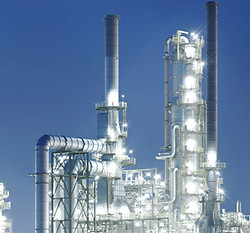
Our Business
Copper Alloys
Coil, Sheet and Plate
Copper alloys are metal alloys that have excellent corrosion resistance and high thermal conductivity and very high electrical conductivity. The best known traditional types are bronze, where tin is a significant addition, and brass, using zinc instead. Applications include architectural uses, coinage, condenser/heat exchangers, plumbing, radiator cores, musical instruments, locks, fasteners, hinges, ammunition components, and electrical connectors.
Steel Industries
Hot Dipped Galvanized Steel Coil and Sheet.
Hot-dip galvanizing is the process of coating iron or steel with a thin zinc layer, by passing the steel through a molten bath of zinc. When exposed to the atmosphere, pure zinc reacts with oxygen to form zinc oxide, which further reacts with carbon dioxide to form zinc carbonate, a dull grey, fairly strong material that stops further corrosion in many circumstances, protecting the steel below from the elements. Galvanized steel is widely used in applications where rust resistance is needed, and can be identified by the crystallization patterning on the surface.
Aluminum Alloys
Coil, Sheet, Plate and Bar
Aluminum is a low density light metal with silver color. The typical alloying elements are copper, magnesium, manganese, silicon, tin and zinc. There are two principal classifications, namely casting alloys and wrought alloys, both of which are further subdivided into the categories heat-treatable and non-heat-treatable. It finds use in a huge variety of commercial applications. The Unalloyed type is ductile, exhibits moderate strength, and is very resistant to corrosion under most circumstances.
Titanium Alloys
Plate and Bar
Titanium alloys are alloys that contain a mixture of titanium and other chemical elements. Such alloys have very high tensile strength and toughness (even at extreme temperatures). They are light in weight, have extraordinary corrosion resistance and the ability to withstand extreme temperatures. However, the high cost of both raw materials and processing limit their use to military applications, aircraft, spacecraft, bicycles, medical devices, jewelry, highly stressed components such as connecting rods on expensive sports cars and some premium sports equipment and consumer electronics.









